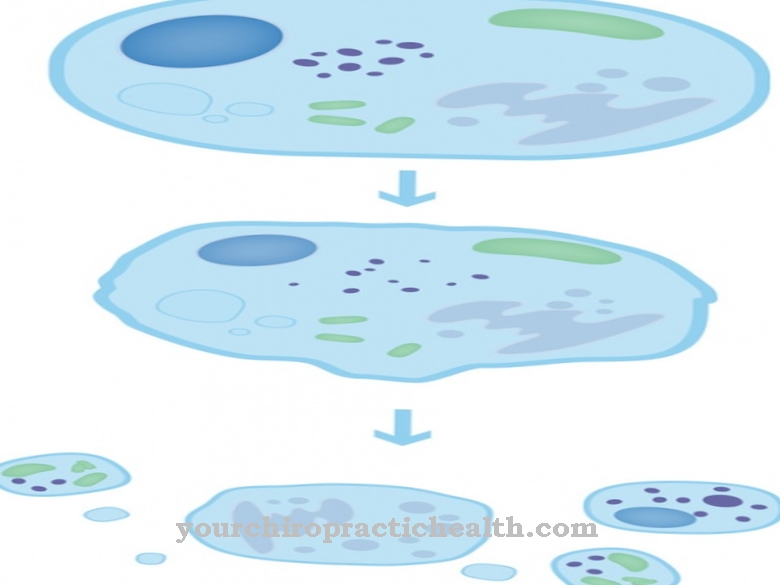The Miosis is the constriction of the pupils on both sides when exposed to light or in the context of near fixation. If there is a miosis without a light stimulus and independent of the near fixation, this phenomenon has disease value. Intoxications are just as possible a cause as meningitis or lesions of the pons.
What is a miosis?

In miosis, the pupils temporarily narrow to up to two millimeters. The constriction can be pronounced either on one or both sides and have different strengths. The reflex corresponds to an eye reflex to light and is subject to parasympathetic control.
The constriction results either from a contraction of the vegetatively controlled eye ring muscle Musculus sphincter pupillae or from a reduced activity of its antagonist Musculus dilatator pupillae. Both muscles are part of the inner eye muscles.
Miosis can be the symptom of various diseases. However, it can also be triggered artificially by administering parasympathomimetics. The opposite of miosis is mydriasis, in which the pupils are dilated by more than five millimeters.
Lens constriction and lens widening are both part of the phenomenon of accommodation. They are physiological in response to certain stimuli. Without a previous stimulus, however, it is a matter of pathological phenomena.
Function & task
The third cranial nerve, the so-called oculomotor nerve, plays a role in miosis. Its nerve fibers come from the accessory nucleus, also known as the Edinger Westphal nucleus. This is an accessory nucleus of the third cranial nerve, located in the mesencephalon and connected to the eye by preganglionic parasympathetic fibers.
The parasympathetic fibers of the third cranial nerve are interconnected in the ciliary ganglion, a ganglion in the eye socket that is responsible for pupillary reflexes. The nerve fibers extend through the Nervi ciliares breves to the Musculus sphincter pupillae.
The reflex arc of the pupillary reflexes attaches to the retina (retina). It continues via the optic nerve into the pretectal area and is interconnected on both sides in the mesencephalon. As a result of this bilateral interconnection, the pupils always narrow on both sides in the case of physiological miosis, as is the case with light stimuli. This also applies if only one eye is directly irritated. For the other eye, we are talking about an indirect light reflex.
The adaptation to the incidence of light is called adaptation. The narrowing reduces the incidence of light and the eye retains visual acuity. The miosis is therefore both a protective reflex and an adaptation reflex.
Physiologically in the broadest sense, miosis also occurs with near fixation. Together with the movement of convergence and the accommodation, the miosis makes up the neurophysiological control circuit of the close-up triad during near fixation. The constriction of the pupils in the context of accommodation helps people to see objects that are close by especially sharply, because the smaller lens generates a greater depth of field. Even in people without lenses, miosis improves visual acuity. This is why it is specifically and consciously brought about by the ophthalmologist for the treatment of various diseases in order to improve the patients' eyesight.
Illnesses & ailments
Pathological miosis can indicate alcohol abuse or drug use. Above all opiates, opioids and morphines cause miosis. The same applies to anesthesia or end-of-life anesthesia.
Miosis can be brought about in a targeted manner by administering medication and then mostly corresponds to ophthalmological therapy, as it can be useful for glaucoma, for example. The targeted induction usually takes place with miotics such as pilocarpine. Miosis is also triggered by medication in the case of a differential diagnosis of certain eye diseases and pharmacodynamic examinations of pupillotonia.
If a miosis for ophthalmological examinations is to be prevented at the moment, the doctor, however, gives mydriatics. Hyoscyamine or atropine, for example, come into question as such, which temporarily paralyze the sphincter pupillae muscle. When parasympatholytic drugs are administered, muscle paralysis is accompanied by a loss of the ability to accommodate, which starts with paralysis of the parasympathetic nerves in the ciliary muscle.
If the miosis was not brought about consciously and also does not correspond to a physiological stimulus response, then it can indicate various diseases. The cause can, for example, be damage to the sympathetic supply, as is the case with Horner's syndrome. The so-called Argyll-Robertson syndrome is also a possible cause of pathological miosis. In the context of this disease, there is usually a reflex rigidity of the pupils on both sides, which is triggered by the neurolues.
A miosis spastica, on the other hand, occurs when the parasympathetic nervous system is irritated. As a rule, this special form of pathological miosis changes into a so-called mydriasis paralytica and can lead to complete paralysis of the oculomotor nerve.
Miosis can, however, also be the symptom of meningitis. This potentially life-threatening infection of the pia mater and arachnoid mater primarily affects children and can either be bacterial or caused by fungi, viruses, and parasites.
Lesions in the pons can equally well trigger pathological miosis. There are various causes for such lesions. Both inflammation and hypoxia or strokes are possible primary diseases.
Not only the presence of miosis, but also the inability to miosis when exposed to light is of disease value and speaks for a parasympathetic paralysis of the sphincter pupillae muscle.



























